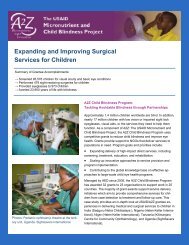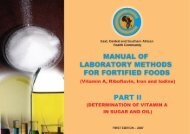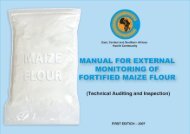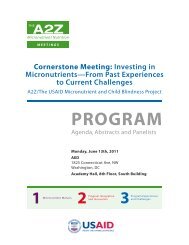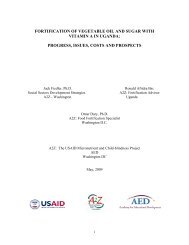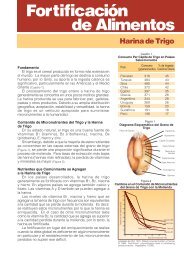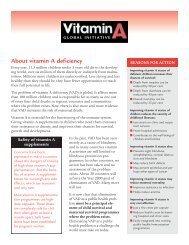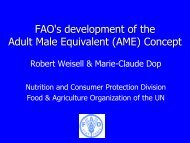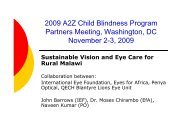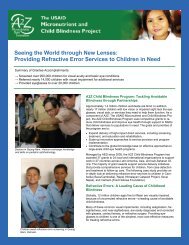manual of methods for determining micronutrients in fortified foods
manual of methods for determining micronutrients in fortified foods
manual of methods for determining micronutrients in fortified foods
You also want an ePaper? Increase the reach of your titles
YUMPU automatically turns print PDFs into web optimized ePapers that Google loves.
C. Calculations<br />
15. Calculate the average <strong>of</strong> the % transmittance <strong>for</strong> each tube with the same volume <strong>of</strong> solution.<br />
16. Calculate the weight <strong>of</strong> cells per tube (mg cells <strong>in</strong> dry weight).<br />
17. Plot a chart with the content <strong>of</strong> cells (mg cells <strong>in</strong> dry weight, X axis) vrs. % transmittance <strong>in</strong> each<br />
solution, y axis. Calculate the equation and calculate the correlation coefficient.<br />
18. Correlation coefficient should be higher than 0.99 to confirm that there is a relation between the<br />
<strong>in</strong>strument response and the concentration <strong>of</strong> bacteria <strong>in</strong> suspension.<br />
Repeat appropriate verification step at least twice more <strong>for</strong> the spectrophotometer to be used <strong>in</strong> the assay.<br />
Draw composite curve, best represent<strong>in</strong>g 3 or more <strong>in</strong>dividual curves, relat<strong>in</strong>g % T to mg dried cell<br />
weight under conditions <strong>for</strong> the assay.Once appropriate curve is established, all subsequent relationships<br />
between % T and cell weight are determ<strong>in</strong>ed directly from this curve. Respective assay limits expressed<br />
as mg dried cells weight/tube are so determ<strong>in</strong>ed.<br />
XII.<br />
Clean<strong>in</strong>g glassware procedure<br />
1. Autoclave the glassware which was <strong>in</strong> contact with the bacteria <strong>for</strong> 30 m<strong>in</strong>utes at 121°C.<br />
2. R<strong>in</strong>se the glassware three times with tap water.<br />
3. Soak the glassware <strong>in</strong> Sodium Lauryl Sulfate (5% v/v) <strong>for</strong> 24 hours.<br />
4. Clean the test tubes with a brush.<br />
5. R<strong>in</strong>se the glassware eight times with tap water.<br />
6. R<strong>in</strong>se two times with distilled water.<br />
7. Dry the glassware <strong>in</strong> the oven at 250 °C.<br />
- 62 -



